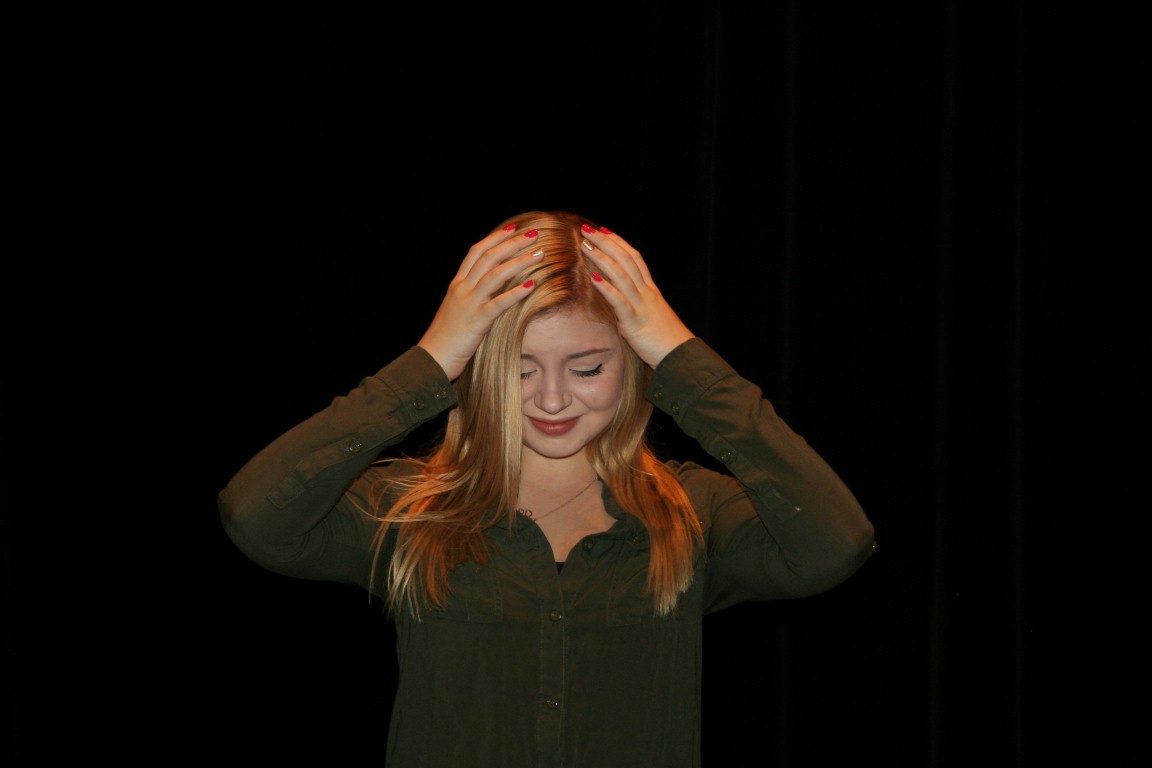Life with dyslexia
How one student deals with her learning disability
November 3, 2014
For stubents wi thdyslexia, reading even thesimp lest of sentneces can be extraordinarily challenging, andthere is no way to sto pit.
Sidney Sorrells, junior, was diagnosed with dyslexia in third grade. She describes dyslexia as a learning disability where the brain cannot understand words and letters like the common brain can. Other students would make fun of her when she was not able to read and write at the level they could, she said.
“It was really hard because I didn’t know I had a learning disability [at first], so I just thought I was stupid and couldn’t understand things like other students could,” Sorrells said. “I would get made fun of because I couldn’t understand even the simplest of things, and I didn’t know why.”
When teachers noticed she was developing slower than other students, they suggested she should get evaluated for a learning disability. Her family began to seek help for her as soon as she was diagnosed and found it through the Davis Program. Created by Ron Davis who struggled with dyslexia, the Davis Program works to improve the learning of people with dyslexia by relying on the mental talents they have. Some of these talents include solving a problem using the whole picture rather than looking at it step-by-step, according to the Davis Dyslexia Program’s website.
“For two weeks I was out of school and they basically taught me how to learn again,” Sorrells said. “I learned the alphabet, how to count, how to add and subtract even though I already knew how to do those things, but this taught me in a way that was beneficial to me.”
Although Sorrells was forced to relearn even the simplest of skills, her mother believes getting diagnosed with dyslexia was the best thing for her daughter.
“I was actually very excited [when Sidney was diagnosed],” Shari Sorrells, Sidney’s mother, said. “Some areas she was excelling in and other areas she really struggled in, we just couldn’t figure out why. When she was finally diagnosed with dyslexia, it was kind of the ‘a-ha’ moment because it all made sense. The artistic part of Sidney was very gifted, but she just couldn’t memorize things, like the times tables. She was very frustrated, but to finally know what was wrong and have options on how to help her was a big relief.”
Sorrells had trouble memorizing basic material because she is a very visual learner and says she has a different way of learning and remembering content than most people.
“I have to re-explain things a lot to myself because some ways that teachers teach lessons aren’t the way that I can comprehend material,” Sidney Sorrells said. “I’m really visual. I do little tricks to remember because my memory isn’t like everyone else’s. I have to bring things from my short-term memory to my long-term memory.”
Dyslexia is a reading disability due to a defect in the brain’s processing of graphic symbols, which is typically characterized by difficulties in word recognition, spelling, and decoding, according to Medical News Today’s website. This learning disability is caused by genetics and is not linked to intelligence in any way. Dyslexia is also not a visual problem, but a linguistic one.
In order to help with tests, the school provides Sorrells with an Individualized Education Program (IEP), which allows her extended time on tests when needed. But for average issues she experiences during the school day, there is not much the school can do for her.
“The problem with dyslexia is that words, numbers, and letters can switch around, but the way that I see it, it looks normal, so I never know when they switch,” Sidney Sorrells said. “I can look at the number 21, when it will actually be 12, and I won’t know, so I’ll be frustrated with how someone found that number. Math is the hardest [subject] for me. When I get stressed [the numbers switch around] a lot, so I have to keep an open mind even if I don’t understand a lesson. I have to remember to stay calm and refocus.”
After evaluating Sorrells, the doctor said it was the worst case of dyslexia she had ever seen. Shari Sorrells became Sidney’s biggest support system and has helped her deal with her learning disability ever since.
“When we told the school district I was dyslexic, they said they didn’t have a program for me,” Sidney Sorrells said. “They put me in with students with special needs, and it took them a while to understand that I needed special accommodations, but not to that extent. She fought for me to get the help I needed.”
The biggest obstacle Sorrells has had to overcome with her dyslexia is trying to explain to teachers how she learns and what she needs from them in order to excel in their class.
“[Sidney has built] her own self-confidence,” Shari Sorrells said. “In elementary school, kids would work on their times tables and would have a star on the wall when they finished one. Everyone in the class had all of their stars up, and she only had her 2’s and 3’s done. She struggled with that, and the hardest thing for her was ‘what’s wrong with me?’ Once she had that diagnosis, she learned how to work around the dyslexia and build her self-confidence. She doesn’t walk around with a t-shirt that says, ‘Hi, I’m dyslexic’. It’s not something she is outing to everyone, but the IEP has taught her that if she doesn’t tell her teachers about her dyslexia, they can’t help her. She has become a very strong self-advocate and has done an extraordinary job. It can be hard because teachers don’t always understand dyslexia and how to modify their lesson plans to help her, so Sidney has to figure that out herself. She has done a remarkable job.”
For Sidney, having dyslexia causes her to do more work outside of school than average students. She often has to go home and reteach herself the lesson in a way that makes sense to her.
“I remember when she was in second grade and she was trying to learn the difference between quarters, nickels, dimes, and pennies,” Shari Sorrells said. “We would go over it every night and finally she would say she had it. I would say, ‘Thank you, we’ve got it! We’re done!’ Then she would go to bed, wake up in the morning and it was like she had never seen a nickel before in her life. It never transferred to her long term memory. She has to put a logic to it and make it sensory learning in order to remember it. She can’t just look at a quarter, she has to touch the quarter, the nickel, the dime, and the penny in order to understand the difference between them.”
Even though Sorrells has been made fun of for her dyslexia in the past and work harder to learn than others, she believes she is blessed to have it.
“There’s good things that come from dyslexia. I have a really strong creative part of my brain and I can think more outside of the box. I excel in music and singing because it’s actually a benefit of dyslexia,” Sidney Sorrells said. “It has taught me to be grateful for having dyslexia. It sounds weird, but it defines me as a person because even though I have a learning disability, it has given me so much more than that. It’s like when a blind person can’t see, their smell is better. For me, since I can’t learn as well, I’m more creative because of it.”
